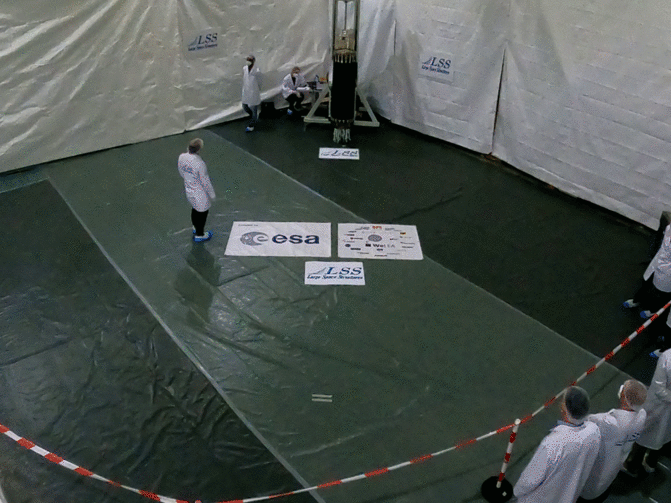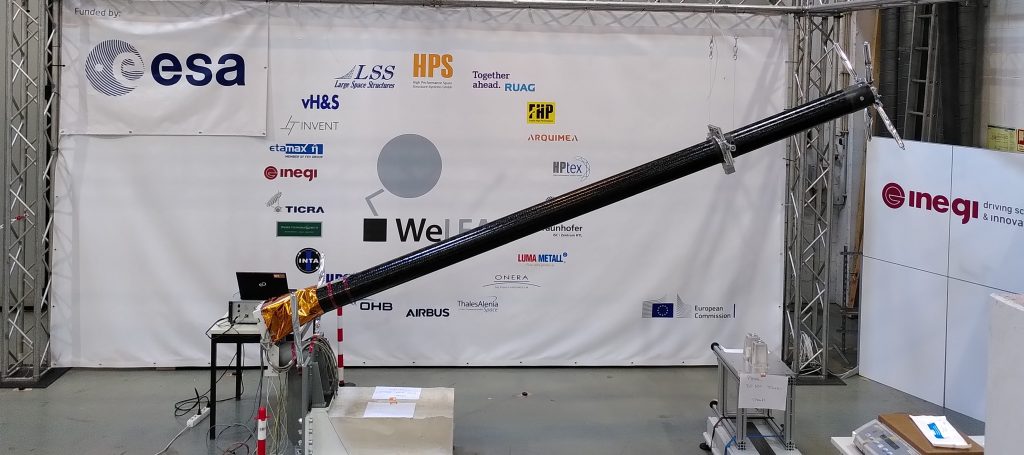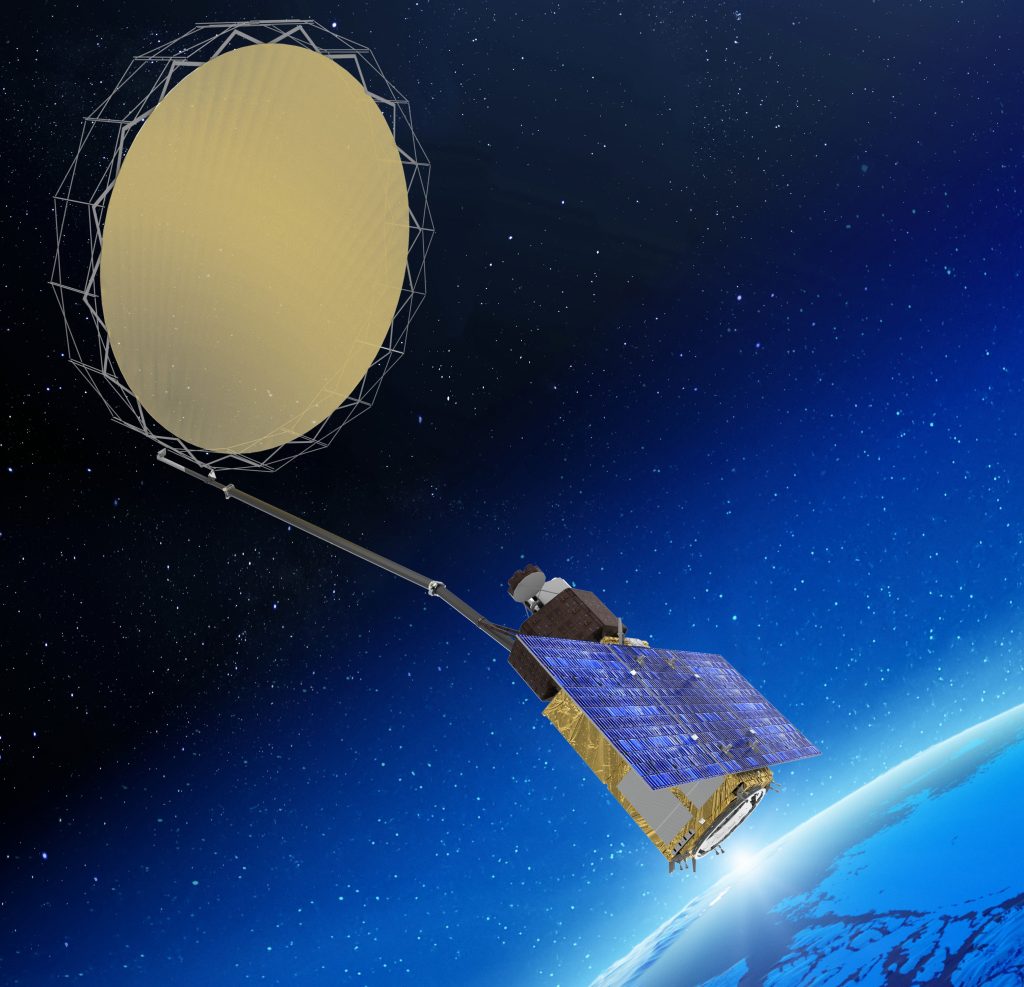Automatic unfurling of European Large Deployable Reflector successfully demonstrated
ESA, HPS GmbH and LSS GmbH have reached an important milestone in the development of the European Large Deployable Reflector or LDR. The team has demonstrated the automatic motorised deployment of the engineering model of the eight-metre wide antenna reflector. The design, build and testing of this full-size engineering model is a significant step forward in the development of the European LDR that will be carried on the Copernicus Imaging Microwave Radiometer (CIMR) mission.
Antennas are essential components of satellites. For example, antennas of Earth observation radars focus the radar pulses on the observed ground area. For imaging microwave radiometers, a bigger antenna equates to a higher spatial resolution on the ground.
Typically, the size of an antenna is limited by the size of the launcher fairing. However, this limitation can be overcome by designing an antenna that can be folded compactly for its time in the fairing during launch and which can then be unfurled to its full size once in space. At the same time, the antenna weight must light and, when fully deployed, the antenna surface must be in the correct shape, stabile and accurate.
Over the last ten years, ESA has initiated a number of activities to develop LDR antenna technology in Europe. When, upon request of the European Union, CIMR was included among the new Sentinels to be developed for Copernicus, an instrument pre-development activity was started to build a full-size engineering model of the reflector for the CIMR microwave instrument.
Under the responsibility of the ESA Φ-Department, a consortium of companies, which was selected competitively in January 2019 to carry out this development, has been working hard to achieve this goal. The consortium is led by HPS GmbH, and LSS GmbH in Munich, Germany.
In May 2021, the consortium reached a very important milestone by demonstrating the automatic motorised deployment of the eight-metre CIMR reflector engineering model at the LSS GmbH facilities. The consortium also developed and successfully tested an engineering model of a deployable arm to hold the LDR on the CIMR satellite.

Alexander Ihle, Structural Engineer at ESA, said: “The deployment test of such a large and complex structure is one of the most challenging tests in the verification campaign of a deployable reflector. It is also a key test that will be repeated multiple times throughout the overall mechanical test campaign. The next tests the reflector will be subjected to aim to verify that it will also survive the stresses of the launch and the harsh space environment. To name a few, the reflector will be tested at INTA in Spain for accelerations of up to 20 times Earth’s g gravity acceleration, temperature swings between –150 and +150 degree Celsius and partial deployments under vacuum. After each of these tests, we will repeat a full deployment of the reflector and inspect it thoroughly to make sure it is mechanically fully functional.”

Jean-Christophe Angevain, Microwave Instrument Engineer at ESA, added: “This first successful deployment of the LDR engineering model developed for the CIMR mission is considered as a major achievement by ESA since it validates the many development steps performed in the last ten years in Europe in different technological areas that were needed for the European LDR technology maturation. It shows that the selected reflector concept is highly scalable and can be designed for large aperture and/or high frequency operation. It also proves that the reflector deployment is robust and reliable, despite the high complexity of such a product.”

The CIMR mission will use a parabolic reflector antenna with a projected aperture diameter of 7.4 m that rotates at 7.8 revolutions per minute. With this antenna, the CIMR satellite will be able to observe sea-ice concentration at a spatial resolution of ≤ 5 km and sea-surface temperature at a spatial resolution of ≤ 15 km over a swath width of 1900 km to achieve frequent observation revisits. The CIMR instrument will measure the brightness temperature of Earth’s surface at 1.4, 6.9, 10.6, 18.7 and 36.5 GHz and at different polarisations.

Craig Donlon, ESA CIMR Mission Scientist, explained: “The CIMR mission is a game changer for Copernicus services and Earth observation in general. It will provide unprecedented spatial resolution and coverage at low frequencies that is required to monitor, operationally, climate change in the Arctic cryosphere, ocean, surrounding land and in the atmosphere. The LDR lies at the very heart of the mission and is a technological quantum leap for the European space sector, not only bringing CIMR to life, but paving the way for new LDR-enabled mission concepts in the future”.
In the coming months the LDR will undergo a comprehensive test campaign at INTA in Madrid, where it will be subject to the environmental conditions that are expected during launch and operation in space. The instrument pre-development activity will finish with the completion of a full qualification test campaign later this year.
Full list of consortium companies
HPS GmbH as prime contractor together with LSS GmbH, Ruag Space Germany GmbH, TICRA, vH&S -von Hoerner & Sulger GmbH, Frezite High Performance Lda, Luma Metal AB, INEGI – Institute of Science and Innovation in Mechanical and Industrial Engineering (RTO), HPS Inovatie si Dezvoltare S.R.L., INTA – National Institute for Aerospace Technology, Airbus Defence & Space GmbH, INVENT GmbH as subcontractors.
To know more: ESA Φ-Department, HPS GmbH, LSS GmbH, WeLEA, LEA – Initiation of LEA-X5 Test Campaign video, LEA-X5 – European 5m X-band LDRS Completed video
 Linkedin
Linkedin